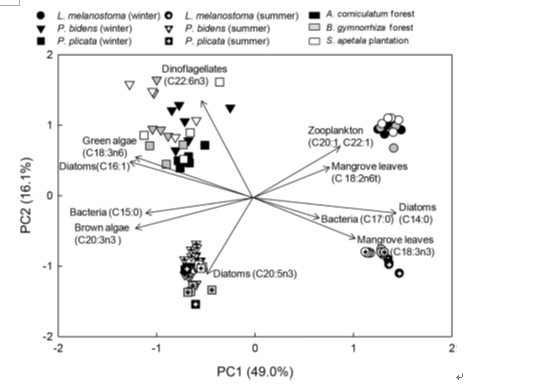作 者:Chen, LZ; Yan, T; Xiong, YY; Zhang, YH; Lin, GH
影响因子:2.179
刊物名称:ESTUARINE COASTAL AND SHELF SCIENCE
出版年份:2017
卷: 187 页码: 160-167
The macrozoobenthos is an important link of the food web in coastal wetlands. Diet-habitat relationships
may significantly depend on qualitative differences and seasonal availability of food sources. Increasing
interest has been shown in food web structure altered by non-native plants. In particular, however, a
non-native mangrove species from Bangladesh, Sonneratia apetala, has been widely planted in China, but
little is known about its possible impact on food sources of macrozoobenthos living in these non-native
mangrove forests. Therefore, in this study, we used fatty acid analysis to compare the food sources of one
littorinid snail and two grapsid crab species between two native mangrove forests and one non-native
S. apetala plantation in the Zhanjiang Mangrove National Nature Reserve of China. We found that the
sediment of all three forests had high diatom and bacteria signals, but low mangrove leaf signals, while
the opposite patterns were detected in the three macrozoobenthos. Specifically, the gastropod Littoraria
melanostoma relied mainly on mangrove leaves and brown algae as food sources, with significant differences
among the three mangrove forests, and showed significant seasonal variation in its diet. The
grapsidae species (Perisesarma bidens and Parasesarma plicatum) mainly grazed on mangrove litter,
brown and green algae, and occasionally consumed diatoms and bacteria, also showing significant
seasonal variation in their diet. Overall, Principle Components Analysis (PCA) of the fatty acid profiles
showed a significant overlapping in food sources among the macrozoobenthos living in the non-native
and native mangrove forests, but significant seasonal variations in their food sources. This suggests that
the planting of non-native S. apetala near original mangrove forests has had little effect on the feeding
behavior of macrozoobenthos some 10 years after planting.

Fig. 7.Scores and associated loadings plot of PCA (Principal Component Analysis) of fatty acid profiles from consumer tissues indicating variance in consumer diet. The first (PC1)
and second (PC2) Principal Components explained 49.0% and 16.1% of the variability, respectively. Arrows are labeled according to the results from the loadings plot, indicating that
the fatty acids contributed most to the distribution of species along each component. The results from the scores plot of the PCA of the consumer fatty acid profiles are labeled as
splattering, indicating the diet variance of consumers.

